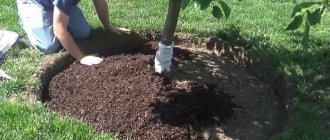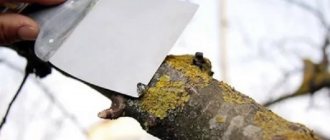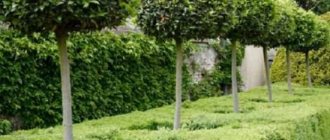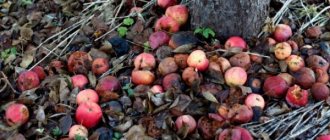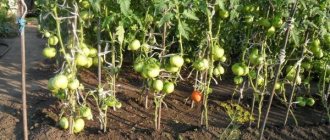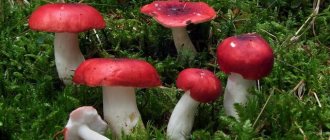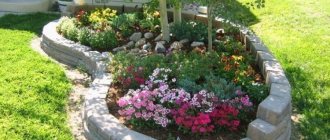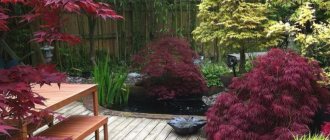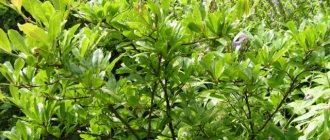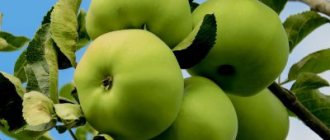Introduction
The most successful solution would be to plant plants that tolerate a lack of sunlight well, and also do not suffer from the chemical characteristics of the soil under the trees and insufficient moisture, due to the fact that the trees take most of the soil water for themselves.
Example of a flower bed under a tree
Ordinary flowers or grass are not suitable for planting under trees : they will be pale and limp, or even wither. Therefore, it is worth choosing plants adapted to such conditions. You can also solve the problem by mulching or sprinkling the roots of the tree with gravel.
When choosing crops for planting under a tree, you should pay attention to the degree of illumination in the planted area:
- partial shade: the sun illuminates the area only in the morning or evening, for 4-6 hours a day
- shade: direct sunlight does not reach the area, it is illuminated for about an hour with diffused sunlight
- deep shadow: no sunlight penetrates at all
Such an analysis will help to select plants in accordance with the conditions of the future location. For areas in partial shade, flowers and shrubs are suitable for which light is not critical, or they can easily tolerate small amounts of it. But in the shade it is better to plant shade-tolerant crops that will produce abundant greenery and bloom even in the absence of light.
What to plant in the trunks of trees and shrubs
You can plant herbs, some vegetables and flowers.
What herbs can be planted in tree trunk circles:
These are dill, coriander, parsley, lemon balm, thyme, mint, oregano. These herbs attract beneficial pollinating insects and also repel pests. Coriander is especially useful - it repels spider mites, thrips, sawflies and apple moths. Read more about herbs in the article Herbs in the garden: 11 best herbs to grow in the garden and vegetable garden
Vegetable crops:
These are onions, garlic, strawberries and tomatoes. It is better to choose small, low-growing tomatoes and plant them under an apple tree in the sunny side of the circle. These plants are also good at repelling pests, especially aphids and sawflies.
Climate under the canopy
Fruit and other trees always greatly influence the conditions for the plants growing next to them. Young trees take all the nutrients for themselves, drying out the soil around them. Large trees create powerful shade.
Without letting in sunlight. Thus, the tree occupies not only the area on which it grows, but also significantly influences plants located at a distance of up to ten meters from it.
The crown of the apple tree allows a lot of light to pass through
To cope with the situation, when planting plants under the canopy of trees, it is necessary to remember such a characteristic as the climate of the tree trunk region of the sub-canopy area. This will help you correctly assess the characteristics of the soil and not make a mistake when buying flowers. After all, it will be very annoying if all the seedlings wither within a week.
Below are brief characteristics of the climate under the crown, depending on which tree the plants will be planted under:
- the crown of the apple tree allows enough sunlight to pass through, so it does not create a powerful shadow, but only protects the flowers from direct sunlight, while the plants have enough light for normal growth
- The spruce tree has a large dense shadow, and it almost does not allow water to pass through. Even in the rain it can be dry under the spruce. Coniferous litter acidifies the soil, so grass cannot be found in spruce forests. In such a situation, you should seriously think about gravel or leave everything as is.
- The pine crown lets in a lot of light, but its needles make the soil quite acidic
- bird cherry creates a thin shade, but dries out the soil greatly, taking away life-giving moisture from the plants growing at its foot
Determining the diameter of the trunk circle of fruit trees
As soon as a tree is planted in the garden, a trunk circle is formed around it. What size a particular plant needs depends on the main parameter - the crown of the crop and its dimensions. During the first year after planting, this figure should be the same as the diameter of the crown. These parameters will change in the future.
Typically, the dimensions of the designated area do not cover the entire crown projection; it is smaller in size. The minimum acceptable value should be 1.5 meters. Every two years this parameter increases by 50-100 centimeters. The type of tree also matters.
For example, the size of the trunk circle of an apple and pear tree is:
- approximately 2 meters for specimens that are already 1-2 years old;
- about 2.5 meters - for crops up to 4 years old;
- approximately 3 meters for crops that are 5-6 years old;
- 3.5 meters – for 7-8 years of age.
The diameter of the trunk circle of plums and cherries is:
- at least 2 meters for trees that are 1-2 years old;
- about 2.5 meters - for plums, cherries, older than 4 years;
- from 3 meters – for 6-8 year old specimens.
For apricots the parameters are as follows:
- 1.5 meters in diameter - for 1-3 years of age;
- 2 meters – for 4-5 year old crops;
- 3 meters – 6-8 year olds;
- up to 5 meters – for 9 year olds.
Areas for plantings must have a horizontal surface (even on slopes). This is an important point so that water from irrigation and precipitation flows well to the roots and does not drain. For exactly the same reason, minor recesses are made to allow full irrigation.
Alternative options
In addition to planting flowers and shrubs, the area under the trees can be used to create a space for relaxation and install a gazebo. This is a particularly good option when planting conifers that do not tolerate “neighbors from below,” as well as other trees that create unfavorable conditions for root vegetation.
Sodding
The grass on the tree-trunk lawn looks just great
Sodding or grassing is the simplest, as well as the most beautiful and budget-friendly way to decorate an area under a tree. With the correct laying of a lawn near the trunk, you can not only create an excellent place for a gazebo, but also solve a complex of other problems:
- improve the overall condition of the soil
- reduce soil salinity
- rid trees of chlorosis
- improve fruit quality
- prevent soil drying out
- protect roots from damage when cultivating the soil
Low grass of a bright green hue, for example, bentgrass, looks especially good on a tree-trunk lawn. She looks very juicy and well-groomed. Also suitable are white clover, meadow fescue, sheep fescue or red fescue, meadow grass and perennial ryegrass.
You cannot tin the soil under trees on clonal rootstocks.
Mulching
Under natural conditions, mulch is continuously formed in the root zone of the tree. Mulch is a covering of natural materials that retains moisture and suppresses weed growth.
Mulching the tree trunk circle
Mulch also protects against:
- erosions
- washing out
- freezing
An important criterion when choosing a material for mulching is the ability to pass air to the trunk, root collar, and tree roots. Also, mulch should not prevent the release of hydrogen sulfide and carbon dioxide from the soil.
Mulching trees: different options
Both organic and inorganic materials can be used for mulching:
1Dry leaves, not damaged by any diseases, help provide the soil with much-needed humus and saturate it with calcium and magnesium. But there are also disadvantages: first the material must be composted, and during the winter pests often appear in the leaves.
2The needles are suitable for soil with low acidity; in addition, it reliably protects the soil from small rodents. But the resin, which inevitably falls on the soil along with it, can negatively affect the processes occurring in the soil.
3Sawdust and wood shavings perfectly retain snow and acidify the soil. But as they decompose, the access of nitrogen to the root area decreases, so before using as mulch, sawdust must be kept for two years with the addition of sand, nitrogen fertilizers and dolomite.
4Mown grass has a beneficial effect on the soil structure and enriches it with carbon. But you shouldn’t make the mulch layer too dense: mucus may form and “burn” the plant.
5Hay is not only very nutritious, but also rots quickly, enriching the soil with minerals, beneficial microelements and other valuable substances. However, hay mulch can attract rodents, slugs, and also encourage the growth of weeds, the seeds of which are often contained in the straw. In addition, bushes and trees with hay mulch take longer to wake up in the spring: it does not contribute to rapid warming of the soil.
6Bark and wood chips are suitable for mulching the trunk circles of mature trees. They are laid in a second layer on top of the compost. But before use, it is necessary to ventilate the mulch to remove toxins. This coating option is durable, but it can provoke a lack of ozone in the soil.
7Cardboard and shredded paper can be used as a bed for grass clippings, leaves or compost. However, since these materials are inorganic, they do not nourish the soil.
8Agrofibre perfectly allows air and moisture to pass through, without forming a soil crust that impedes drainage and aeration of the soil. The main disadvantage of such mulch is that it must be removed when fertilizing and loosening, and then laid back.
9Stones, tracing paper and gravel help create a comfortable level of humidity and healthy heat exchange of the root zone. However, such mulch negatively affects the acidity of the soil and slows down the accumulation of useful organic matter.
10Compost improves the structure of the soil, perfectly controls evaporation, provides good drainage, and nourishes the soil with useful substances and microelements. This is the best option for mulch made from natural organic material.
Why do you need a trunk circle around a tree in the garden?
Recently, debates have often arisen about the benefits of tree trunk circles around garden trees. Some gardeners claim that they are unnecessary, since in natural conditions trees feel good adjacent to other plants. Others refuse them, believing that tree trunk circles disfigure the lawn in the garden, especially when several trees are planted on the site and all are surrounded by these circles. Let's look into this issue.
When planting a new tree or shrub among already growing plants, the root system of the seedling is not yet strong and it is difficult for it to compete with old plantings for moisture and the soil microelements it needs. Such a seedling needs good conditions for its development: trees are about 2-3 years old, bushes - at least a year. Also, a development problem arises if you decide to surround a fresh seedling with flowers or lawn grass. These “neighbors” develop faster and draw almost all useful substances from the soil, thereby limiting the growth of the seedling.
When it comes time to mow the lawn, gardeners are often faced with the problem of processing the area near the bushes. Their branches often bend towards the ground and need to be constantly lifted while cutting, which is inconvenient. This is where tree trunk circles come to the rescue, making it easier to mow the lawn.
Another advantage of the tree trunk circle is the convenience of applying moisture and fertilizers under the tree. Many gardeners do not plant anything around fruit trees at all, but make the trunk circle in the form of a depression; they are filled with mulch to retain moisture.
You can also watch this video about the benefits of the tree trunk circle
Flowers under the trees
To decorate the root zone of trees with flowers, low perennials that love shade, as well as beautiful biennials and annuals, are best suited. They will have to be planted more often, but, as you know, beauty requires sacrifice.
Bright flower bed under a tree
Perennial flowers are chosen not only for practical reasons: among them there are most shade-loving species that prefer places protected from sunlight. A large number of shade-loving perennial flowers makes it possible to create original flower beds and compositions in the shade of garden trees.
How to plant flowers correctly?
As a rule, such plants grow naturally in the forest, so for rapid growth and rich flowering they need fertile soil with a high humus content. Such soil quickly absorbs and retains water well, and is well ventilated.
Since the soil in the garden bears little resemblance to forest soil, one cannot do without using fertilizers that will enrich it with the substances necessary for the growth of forest flowers. Compost is best suited for these purposes. The compost is spread out in a layer 5 cm thick and then carefully mixed with the top layer of soil. Every year in autumn and spring it is necessary to add 2-3 cm of fresh compost layer.
Leaves falling from trees can also be used to increase soil fertility. They cover perennials to protect them from frost, and in the spring they are transferred to the compost heap, where they will turn into fertilizer.
How to make a bed under a tree
It is advisable to lay a bed in the tree trunk immediately after planting the tree itself. The fact is that many fruit crops have thin suction roots located close to the surface along the entire perimeter of the crown. Therefore, digging with a shovel on a bayonet can damage them and worsen the condition of the tree itself.
To avoid this, you need to immediately clear the weeds and dig up the planned piece of land, fence it off, and apply fertilizer.
If the tree has been growing for a long time, and you decided to plant vegetables only now, you first need to clear the circle of weeds from the tree trunk. You cannot use a shovel or herbicides for this; you can only carefully weed or use a non-woven covering material.
The cleaned soil will need to be checked for acidity level (if it is elevated, add dolomite flour to the top layer of soil at the rate of 0.5 kg per 1 sq.m.), add seasonal fertilizers (30 g of urea, 25 g of superphosphate, 20 g of potassium sulfate per 1 sq.m. .m). After this, you can begin planting, and it is advisable to mulch the seedlings with plant material (hay, mown grass, peat, etc.).
Do not make a bed in a tree trunk circle with a radius of more than 80-90 cm, otherwise it will be inconvenient for you to care for it.
Plant the plants themselves at a distance of 15-20 cm from the trunk so that the root collar of the tree does not come into contact with the tops and is not shaded. Also make sure that the mulching material does not cover the lower part of the trunk, as otherwise the process of rotting may occur and the tree will suffer.
What flowers and plants are suitable for planting?
Below is a short list of flowers that will feel comfortable in the shade of trees.
Periwinkle
Lesser periwinkle Lesser periwinkle is an evergreen shrub that reaches a height of 15 cm . It belongs to forest plants that prefer beech, oak and sometimes pine forests, as well as bushes. In its natural environment, periwinkle grows on slopes near river valleys, as well as on the upper and middle parts of the slope, in clearings.
This plant loves shaded areas with moderate soil moisture. Periwinkle is often found on gravelly and rocky slopes, so it will thrive in the garden near stone or crushed stone mulch.
Soil and care
The plant is a shade-tolerant species and does not grow well in the sun, but the optimal option for it is moderate darkening. This is an excellent option for planting in open ground, as it tolerates frost well, is resistant to bad weather and is easy to care for.
Periwinkle is also unpretentious to soil, but fertile soil with good drainage ensures more powerful flowering.
The plant is responsive to fertilizing and fertilizers of organic origin. It is best to use humus, compost, or leaf soil for these purposes. To achieve good bushiness, you should pinch old and young shoots from time to time. For the winter, it is better to cover the periwinkle to protect it from freezing.
Periwinkle delights the eye with its blooms throughout spring and summer. The flowers are small in size and have a delicate purple hue. The small periwinkle does not suffer at all from severe darkening, but needs soil with a high level of fertility and moderate moisture. If you plant it in a dry place, then frequent watering cannot be avoided.
Creeping tenacious
Creeping tenacious Creeping tenacious (Latin name Ajuga reptans) is a herbaceous perennial that grows up to 20 cm in height. The plant owes its name to its unpretentious nature: the tenacious feels comfortable in almost any conditions.
It easily survives drought and grows both on fertile soil and on rocky soil. In nature, it is often found in deciduous forests and in the shade of dense bushes. Therefore, under a tree in the garden you will feel at home.
The plant prefers soil with a high content of limestone. This is an excellent option for a tree growing on a slope. Creeping tenacious will not only decorate the root zone, but also prevent soil erosion.
Creeping tenacious has soft, short-haired leaves, and in May and June it delights gardeners with blue and purple flowers. Today, about 40 varieties of this plant are known, which grow in various parts of the planet.
Initially, the flowers of the tenacious were blue, but through the efforts of breeders, many varieties of different shades were obtained.
The main differences between the species are:
- plant height
- leaf shape
- flowering duration
- bud color
- presence of a pattern on the leaves
For example, the Burgundy Glow has multi-colored leaves that change color depending on the type of soil and the level of light in the area. The leaves can be brownish, lilac, or red. Such a rich color palette creates a stunningly beautiful floral carpet. This variety feels great in the shade of bushes and trees.
Another variety of creeping tenacious, impressive in its beauty, is Multicolor . Its purple leaves have red, yellow and orange splashes. Depending on the lighting, the greenery takes on one shade or another, creating a rich texture of the green carpet.
Planting and care
In order for the tenacious to feel comfortable and please the eye with an abundance of greenery, it is necessary to follow the basic rules for planting this plant and caring for it: The tenacious is propagated by seeds or by dividing bushes. But for successful planting, you first need to prepare the soil under the tree.
This should be a moderately dark place, preferably loam with a high humus content. Seeds are sown in pre-prepared holes and carefully sprinkled with soil.
Speckled lily
Speckled lily Speckled lily (Latin name Lamium maculatum) reaches a height of 20-30 cm and is a perennial wild plant. Europe, Iran, the countries of Asia and North Africa are considered to be the birthplace of the claret.
The plant has many species, some of which are classified as weeds. But a number of varieties are successfully used in landscape design, for example, speckled or spotted yamyami.
With the help of jasmine, you can create a beautiful flowering carpet at the foot of the trees. Its hollow stems spread along the ground, taking root at the nodes. It has heart-shaped, jagged leaves and pink or purple inflorescences. Speckled lily blooms from July to August.
Planting and care
Speckled jasmine should be planted in shaded areas with a sufficient level of humidity. It will feel most comfortable under the canopy of a tree, but may require watering during dry periods. It is better to plant the plant on the western or eastern side of the garden plot.
Yasna has no requirements for the composition of the soil, the main thing is that it is loose and with a good drainage system. If the soil is rich in nutrients, then the jasmine grows into a lush carpet, but its decorative properties deteriorate. Therefore, you should not overuse feeding.
Pachysandra apex
Pachysandra apical Pachysandra apical (Latin name Pachysandra terminalis) is a low shrub 30 cm tall with dark green shiny leaves. Pachysandra belongs to the evergreen plants of the boxwood family, which have a highly developed rhizome.
There are four species in the pachysandra genus, three of which originally grew in East Asia, and one in North America.
Appearance
Pachysandra apex is an ornamental plant that is used in landscape design. A subshrub with non-woody shoots spreads along the ground, creating a dense cover in the shade of a tree that does not change its appearance throughout the year.
This is an excellent option for decorating a garden plot in a region with a warm climate. In May-June, its greenish-white flowers bloom, which add additional elegance to the plant.
The leaves on short petioles are 5-8 cm long, they grow in tiers, each of which lives for three years. Biennial leaves grow on the lower tier, annual leaves grow on the middle tier, and young fresh shoots grow on the upper tier.
Growing conditions
This plant needs protection from frost, especially if there is little snow, and during dry periods it will require additional watering. The plant easily tolerates frost up to 30 degrees, but does not like wind. Pachysandra apex does not tolerate direct sunlight; it does best in the shade. In the bright sun, its leaves become faded and inconspicuous.
During the rooting process, the plant needs moderate watering, and then is content with natural moisture from precipitation and groundwater. Pachyzadra prefers turf or leafy soil mixed with sand. Feeding is not required, nor is loosening. Diseases and pests avoid this plant.
Biennials
Despite the great popularity of perennial plants, which do not need to be renewed every year, biennials are also popular with gardeners. After all, sometimes you want variety, and not see the same flowerbed year after year.
Pansies
Pansies The most popular biennial is Pansies. The plant has many varieties, each of which has beautiful inflorescences of bright colors. You can choose one color, or sow several types at once to create a variegated flower carpet.
The appearance of these flowers is especially impressive in the spring, when they bloom in lush spots in the shade of trees. The second name for pansies is viola.
These flowers have long become a favorite plant of gardeners, who appreciated:
- rich color range
- frost resistance
- miniature flowers
All this has made Pansies one of the most popular garden plants for several centuries.
Growing conditions and care
Pansies feel comfortable in the shade of trees and get along well in the vicinity of many other flowers: daffodils, tulips. Hybrid varieties bred by breeders tolerate both frost and cold well.
Therefore, they can be planted in the spring. Both in summer and autumn. In addition, they are extremely unpretentious, and bloom richly even in the most modest conditions.
Forget-me-nots
Forget-me-nots Another option for luxurious decoration of the root zone of trees is forget-me-nots. They grow well in low light conditions and delight the eye with their bright blue inflorescences.
Forget-me-nots have long been used in folk medicine to treat pulmonary diseases. But they won the hearts of flower growers precisely with their beauty, and not with the possibility of practical application. They are planted in gardens in many countries around the world.
Care
Forget-me-nots do not require special care; they grow well in the shade and in infertile soil. They grow best in fresh soils with sufficient but moderate moisture. Forget-me-nots bloom in May and continue until mid-July.
In the shade, the duration of the flowering period increases, so under the tree the carpet of flowers will be especially impressive. Sometimes they are planted in combination with ferns for additional shade.
Plants for trees with tall crowns
In the shade of tall trees, low shrubs and flowers with tall inflorescences look great. If they are lost in combination with young trees, then the tall, large trunk of an adult tree will look quite impressive against their background.
Khosta
Hosta Hosta (Latin name Hosta) has several varieties, each of which has its own characteristics of appearance and height. For planting under the crown of a tree, a hosta with evenly green or grayish leaves is suitable.
These varieties survive the lack of light best. If the soil is sufficiently moist, the hosta will delight the eye with magnificent foliage. In addition, it goes well with other annuals and perennials.
Volzhanka vulgare
Common Volzhanka Common Volzhanka (Latin name Aruncus dioicus) reaches a height of 150 cm. It is a perennial shrub with lacy feathery leaves. The plant has paniculate inflorescences of small white and greenish flowers.
Volzhanka vulgare blooms from June to July. The only significant disadvantage of the shrub is its intolerance to drought; watering will have to be carefully monitored.
Ferns
Ferns Ferns are an excellent option for decorating an area under trees. There are many varieties of this plant, but for areas with heavy shade, the male shield plant (Dryopteris filix-mas) is best.
It needs moist soil with a high content of humus.
Viburnum common
Viburnum Viburnum Viburnum feels great in the shade. This tree is small in height, reaching about 90 cm. In spring, viburnum delights with its small flowers, and in autumn with beautiful berries.
It can also be used as a hedge.
Hydrangea paniculata
Hydrangea paniculata Hydrangea paniculata will do well in places. Where light penetrates only after lunch. Its inflorescences in the form of fluffy panicles bloom quite high above the ground.
They start out white and then, as they ripen, turn pink and then bright pink.
Red and black currants
Red and black currants Both red and black currants love moisture very much, so they are afraid of strong sun and feel comfortable in the shade of tall trees. Worth keeping this in mind.
That when planted in the shade, the berries on the bushes will ripen more slowly.
Raspberries
Raspberries Raspberries feel great in the shade of trees and bear fruit with fragrant and large berries. Like all shade-loving plants, it prefers fertile, moist soil.
Irga
Irga Under natural conditions, the game grows under the forest canopy, so it will be comfortable in the garden in the shade of trees. This is a great opportunity not only to decorate a dark area of the garden, but also to eat delicious berries.
Ivy
Common ivy Common ivy (Latin name Hedera helix) is an evergreen climbing shrub, the shoots of which reach a length of 30 m. It grows well under the shade of trees with sufficient moisture.
Its shoots can be twisted around a tree trunk to create a more aesthetically pleasing appearance.
European hoofweed
European hooffoot European hooffoot (Latin name Asarum europaeum) is a perennial plant and reaches 10 cm in height.
The plant owes its name to its dark green, hoof-shaped leaves.
Flower bed under the garden canopy
- VK
- Youtube
Every owner of a plot of land wants his garden, in which there are many trees and shrubs, to be surrounded by greenery and flowers. Not every amateur gardener succeeds in creating a flowering mosaic under the canopy of trees. Sometimes the reason for failure should be sought in the wrong selection of plants, or in the improper care of these plants. And sometimes poor-quality pre-planting soil preparation leads to the fact that after some time the trees themselves and the plants underneath them wither.
If you have a birch tree growing in your garden, then you have probably noticed that almost nothing grows under it except grass. This is explained by its powerful superficial root system. Its roots, as well as the roots of spruce and Norway maple, absorb too much water, thereby depriving the plants growing under them. Plants also do poorly in the trunk circles of horse chestnut and beech. In this case, the cause is unfavorable lighting conditions. Does not allow other plants and walnuts under its crown. This powerful fruit tree has developed a completely different strategy in the struggle for living space: its autumn foliage contains essential oils that inhibit germination and plant growth.
Not everything is so sad in the garden world. Most trees, including apple, rowan and hawthorn (Crataegus 'Carrierei') and oak and pine, allow you to turn their bare trunk circles into real flower beds. Such trees have a deeper or tap root system, that is, one or more roots go vertically into the depths and do not penetrate the upper layers of the soil so intensively. Suitable perennials, ornamental grasses, ferns, flowers or small shrubs do well in the trunks of such trees.
Perennials will ideally take root under a pine tree
It is good to place plants under trees with a narrow, columnar crown shape, such as common juniper (Juniperus communis) `Hibernica`, Lawson cypress (Chamaecyparis lawsoniana), berry yew (Taxus baccata) `Fastigiata`. Trees such as black locust (Robinia pseudoacacia) `Umbraculifera` or hawthorn (Buxus sempervirens) `Globosa` have a spherical crown, under which there is also plenty of space for other plants. The openwork, fan-shaped crowns of Maak honeysuckle (Lonicera maackii), Japanese ornamental cherry (Prunus serrulata) `Shidare Sakura`, and reflexed lilac (Syringa reflexa) let in a lot of light and rainwater, which is an important factor for the growth of “lower tier” plants.
Blooming flower beds under the crowns of Robinia pseudoacacia 'Lace Lady'
Suitable plants for planting under a tree crown
Under the crowns of trees, large tracts of herbaceous perennials, ornamental grasses and ferns not only feel good, but also look harmonious, that is, plants that naturally grow in forests and that are accustomed to the constant struggle for light and water. Despite this, they also need to create good starting conditions for active growth and development in a dense network of intertwined tree roots.
Fruit trees have a well-developed superficial root system, so it is best to plant perennial plants under them that do not require deep digging and frequent replanting. If you care about the health of your fruit trees, plant nettles under them. This is our good ally in the fight against aphids and ants. Chamomiles and marigolds planted in the tree trunk repel nematodes, and non-climbing nasturtium protects apple and cherry trees from blood aphids and apple worm. Interestingly, garlic in combination with non-climbing nasturtium protects peaches from leaf curl, and dandelions under the crown of apple and pear trees serve as a good indicator of chlorosis caused by a lack of iron in alkaline soils, as a result of which green leaves and shoots become yellow and the trees gradually dry out. Lilies of the valley in the tree trunk will protect cherries from fruit rot or moniliosis, and tomatoes (!) will protect apricots and peach from ants and aphids.
Nasturtium in the tree trunk
Do you want to create a real flower garden under the crown of a tree? Then pay attention to the most grateful and responsive beautiful flowering plant - geranium. In addition to sun-loving species, there are many species and varieties that tolerate shade and slight drought. Among them are medium-sized forest geranium (Geranium sylvaticum) and meadow geranium (G. pratense), reaching up to 80 cm in height, magnificent geranium (G. x magnificum), which over time forms a thick carpet, covered in June with many bright flowers. A low-growing colorful carpet is formed under the canopy of trees by the lushly blooming Renard geranium (G. renardii) with velvety olive-green leaves, or Enderss geranium (G. endressii). Growing well in shade and tolerating dry soil, Oxford geranium (Geranium x oxonianum 'Claridge Druce') blooms from July to September with veined pink flowers.
Geranium forms a beautiful thick carpet under the tree canopy
Low shrubs can also be successfully grown under the canopy of trees in openwork or dense shade. Ivy, for example, is a hardy climbing plant that thrives in the dense shade of coniferous trees. Manchurian hazel, honeysuckle or deciduous shrubs such as alpine currant (Ribes alpinum 'Schmidt'), species and varieties of snowberry (Symphoricarpos) create harmonious pictures in the shade of trees.
And for birch, which actively takes water from the soil, there are suitable plants, including hosta siebold, Cantabrigian geranium and Dalmatian geranium, heuchera, fragrant bedstraw
In the shade of trees with dry or wet soil?
When selecting plants to decorate the tree trunk, pay attention to the fact that shade-tolerant plants have different requirements for soil moisture. Astilbe, for example, needs evenly moist soil and prefers, depending on the variety and type, rather light shade. Therefore, it should not be planted on the northern border of the tree trunk circle, or near the tree trunk, where it is especially dark and dry. This place is more suitable for such shade-tolerant plants as large-rhizome geranium (Geranium macrorrhizum), Waldsteina geoides, Cambrian meconopsis (Meconopsis cambrica), stinking hellebore (Helleborus foetidus). The closer to the outer border of the trunk circle, the greater the choice of plants for planting, since species that prefer slightly moist soil are planted here. These include, for example, hosta (Hosta), all the beauty of which is revealed precisely in the shade, heuchera, from spring to autumn decorating a flowerbed under the crown of a tree with an unsurpassed play of colors on the leaves, large astrantia (Astrantia major), which does not lose its delicate colors until autumn, purple foxglove (Digitalis purpurea), bright red gravilate (Geum coccineum).
Cuff under the canopy of fruit trees
When creating a composition under the crown of a tree, pay attention to ensuring that there is a balanced ratio between flowering and decorative foliage plants. For best results, also include ornamental grasses and ferns in your planting. Athyrium niponicum 'Metallicum' brings a lot of color to the composition. Its leaves, iridescent pink, have a silvery coating, and the central veins are burgundy in color. Easy-to-care Morrow sedge (Carex morrowii 'Variegata') with narrow light green leaves with white stripes, forming lush bushes, will fit perfectly into a single picture of a flower bed created in the tree trunk.
Flower garden under a tree
The main thing when selecting shade-tolerant plants is to take into account their height in maturity - the lower branches of the tree should not touch the plants, otherwise the overall picture will not be so impressive. When using plants of different heights, the tallest ones should be planted closer to the tree trunk, the shortest ones - on the border of the tree trunk circle.
Proper planting of plants under the crowns of existing trees
Anyone who has tried it at least once in their life knows how difficult it is to dig up the root-grown soil of tree trunks. In addition, during digging you can damage the roots. Therefore, first of all, you need to get rid of weeds and lawn grass under the tree crown. Then use a shovel to find free spaces between the roots and mark them with short sticks. After you have marked all the locations of suitable perennials, remove the top layer of soil about three centimeters thick, make small holes and plant the plants. Immediately before planting, it is recommended to immerse the root ball in a container of water and hold it until bubbles stop appearing. Loosen the wet root ball, straighten the roots if possible and plant the plant. In conclusion, the tree trunk circle with new “settlers” should be watered again and covered with bark mulch. A 5-centimeter layer of mulch retains moisture well in the soil and, gradually decomposing, additionally enriches it with humus - an indispensable elixir of life for all forest perennials.
You should not cover the tree trunk circle with a layer of plant soil; many trees do not like this. Neither soil nor mulch should be poured onto the tree trunk, which can lead to rotting of the trunk or the appearance of adventitious roots. Leave the circle free at a distance of at least 20 centimeters from the trunk. After all the plants have been planted, the area should be well watered and continue to be watered until the plants are established.
Important: regularly monitor soil moisture and water it if necessary, since during active shoot growth (until the end of June), trees, especially those with a shallow root system, take a lot of water from the soil. In addition, the dense crown of some trees not only does not transmit sunlight well, but also acts as a natural umbrella that protects the plants of the lower tier from rain.
Planting under tree crowns can be done from spring until autumn, but the best time is late summer. During this period, trees, especially fruit trees, almost stop growing and consume less water from the soil. And perennial plants have time to take root and gain strength before the onset of cold weather to fight for their “place in the sun” next spring.
Translation: Lesya V. especially for the gardening internet portal
Publication date: May 21, 2011
comments
Lesya Vasko
If you notice an error, select the required text and press Ctrl+Enter to report it to the editors
Comments:
There are no comments yet, you can add your own comment. For this you need to register or log in.
Authorization
You have entered an incorrect login/password
adding a comment
Vegetable garden in the shade of trees
You can grow herbs and root crops in the shade of trees
If on a spacious plot you can place a gazebo or lawn under a tree, then in conditions of limited space every piece of land counts. A way out of the situation may be to plant vegetables and herbs in the shade of trees that are not picky about the amount of sunlight.
This way you can not only decorate the root zone around the tree, but also harvest root crops, herbs and other garden crops.
But, before planting a vegetable garden under a tree, you need to take into account a number of nuances:
1when protecting trees from pests, chemicals may be required that will also affect vegetables under the crown
2some crops have a developed root system and can harm the tree under which they grow
Digging beds under a tree can damage its roots
If a gardener decides to plant beds under a tree, you should pay attention to the following crops:
- perennial onions: in addition to greenery, they can bloom beautifully. For example, chives have huge lilac caps. No worse than regular flowers
- shoots of young wild garlic are good for health, and the plant itself feels great in the shade
- rhubarb thrives in conditions of lack of sunlight
- beets in the shade only become sweeter, but the root vegetables will be small in size
- borage grows best in heavily shaded conditions. Borage is not afraid of spring cold snaps and does not require special care
To summarize, it can be noted that the shadow of trees is not at all a reason to refuse blooming greenery under the canopies. There are many flowers and shrubs that thrive under the protection of a tree crown. The main thing is not to forget about hydration and provide a sufficient amount of nutrients by regularly fertilizing the soil with compost.
Whether in the garden or in the vegetable garden
If we talk about vegetable crops, then those whose peak nutrient consumption does not coincide with that of fruit crops are more suitable for row spacing. Typically, the “consumer” season for fruit and berry crops occurs in the first half of summer, when the outflow of nutrients and moisture from the soil is most significant.
It is during this period that plants actively undergo the processes of growth of shoots, leaves, setting and enlargement of fruits. Consequently, the “neighbors” must need water and nutrients in the second half of summer. Therefore, you can choose root vegetables and potatoes, as well as legumes, which will also enrich the soil with nitrogen - even if the harvest does not impress you, legumes can be dug up.
In a young garden or where the row spacing is large, you can also grow strawberries. But when cultivating it, it is imperative to carry out a thorough fight against the larvae of May beetles. And one more drawback: all spraying, which is mandatory for the garden, is often carried out during the period when the strawberries are blooming or there are already fruits on them. This is unpleasant, but can be solved if the area is small - in this case, the strawberry plants can be covered with plastic wrap. By the way, they do the same with cultivating vegetable crops or herbs between rows.
A big disadvantage of the proximity of vegetable and fruit crops is the invasion of mice, attracted by the “tops and roots” and gnawing the bark of young trees, which may even die from such vandalism. In addition to cleaning up plant debris, it is also necessary to take simple measures against the accumulation of mice - lay out poisoned baits, set traps.
All this time we have been talking about fruit trees. How to solve the problem of “empty spaces” between berry bushes? The row spacing of berry gardens is small, and they themselves grow faster, so between the rows of gooseberries, currants, raspberries and other shrubs it is possible to grow a very limited range of vegetables (lettuce, radishes, onions, garlic) - and only in the first three years of the plants’ life.
Garden crops and herbs
If the apple tree does not need periodic spraying with chemicals during the summer, then plants used for food can be planted in the circle around the trunk. Many of them develop well in partial shade.
Garlic is one of the neighbors that is favorable for the apple tree. Planted before winter, it preserves the root system of the tree from being eaten by rats, and in the summer it releases healing phytoncides into the soil. In this case, the heads are formed as standard, and the greens are much richer than in the sun.
You can plant peas and climbing beans in the tree trunk circle (except for the “Vigna” variety - it is very capricious). These crops look spectacular if they are tied to the lower tier of branches. By adding a little peat and sand to the soil, you can successfully grow wild garlic.
Sorrel and spinach placed under an apple tree can produce a rich harvest. In partial shade, these crops form powerful, spreading bushes with succulent leaves, provided that the soil is sufficiently nutritious and well moistened. A variety of leaf lettuces will also grow well.
cucumbers
Many gardeners actively share their experience of successfully growing cucumbers under apple trees. This is quite feasible if the crown of the tree is correctly formed, thinned out, and the lower branches are high enough from the ground. Cucumbers are planted no closer than a meter from the trunk, or better yet, closer to the edge of the trunk circle. Rotted manure is first applied to the soil. But it is best not to disturb the roots of the apple tree by digging, but to place several tanks or buckets without a bottom around the tree. Coarse compost is poured down, then good humus mixed with soil, where cucumber seedlings are planted.
Cucumber vines are light, so they can be tied to the lower branches of an apple tree. This is useful not only from the point of view of the purity of vegetables, but also for prolonging fruiting: directly near the ground, the air temperature is lower than at a distance of 1-2 m, so autumn night cold snaps will not be scary for the vines for some time.
We recommend reading: Animals of Antarctica. Description and characteristics of animals of Antarctica. The article will tell you in detail about the fauna of Antarctica and the characteristics of the animals living there
Cucumber tendrils readily cling to the tree, making their way into the crown. The foliage of the apple tree protects them from cold dew and partly from rain, so the lashes are much less likely to be affected by downy mildew.
Advice
Cucumbers under an apple tree will produce more female flowers if you feed them with “fermented water”: several moldy pieces of bread are soaked in a bucket of water, which is exposed to the sun. When bubbles appear, the solution is mixed several times, then used to water the cucumbers.
Pumpkins and zucchini
Pumpkins and zucchini can also be placed under an apple tree if the tree trunk is well open and is illuminated by the sun for several hours.
An example of a landing option:
- the area under the apple tree is mulched with a thick layer of rotted manure mixed with shavings;
- holes are made in the mulch, which are filled with fertile soil;
- Germinated seeds are laid out in the holes or seedlings are planted.
Important!
You should not plant both pumpkins and zucchini under the same tree.
Tomatoes
Resourceful summer residents place rooted stepsons of tomatoes under apple trees, which are a pity to throw away after treating the bushes in greenhouses. Some people initially plant several tomatoes in the tree trunk to repel pests (the codling moth does not tolerate the smell of tops), but as a bonus they also get a decent harvest of fruits.
It should be noted that growing tomatoes in unprotected soil is the prerogative of the southern regions. In most regions of Russia, such experiments can end in failure: the growth of the bushes will be suppressed, late blight will overtake them early, there are few fruits, they ripen slowly. But in a successful summer, the harvest may well please.
Basic rules on how to make a tree trunk circle for fruit trees
Despite the fact that there is a huge variety in the design of such an area, several important rules should be followed:
- the root system of any crop needs free space and a sufficient amount of oxygen, thanks to this the plants bear fruit well;
- It is not allowed to block young specimens with various decorative fragments, as this can cause poor development of the crop; during the first 5 years, it is recommended to decorate using organic matter;
- Under mature crops, it is practiced to plant greens - cilantro, parsley, dill; this solution is not the best, since when processing trees, chemicals can get on the greens.
Compliance with these rules will allow you to get healthy plants and a well-groomed, beautiful place on the site.
What can be planted under trees with a high crown
Even old tall trees with a spreading crown are not a reason to deny yourself the pleasure of seeing flowers under them. Especially for planting under such trees, we offer you a list of suitable crops:
- Hosta. An evergreen ornamental plant with gray leaves.
- Volzhanka is a herbaceous shrub with feathery lacy leaves. It blooms in June and July with white paniculate inflorescences. Doesn't like drought. Looks great near the fence, hiding various flaws.
- Fern. Ideal for planting under canopy. It will not bloom, but it will delight you with its giant leaves.
